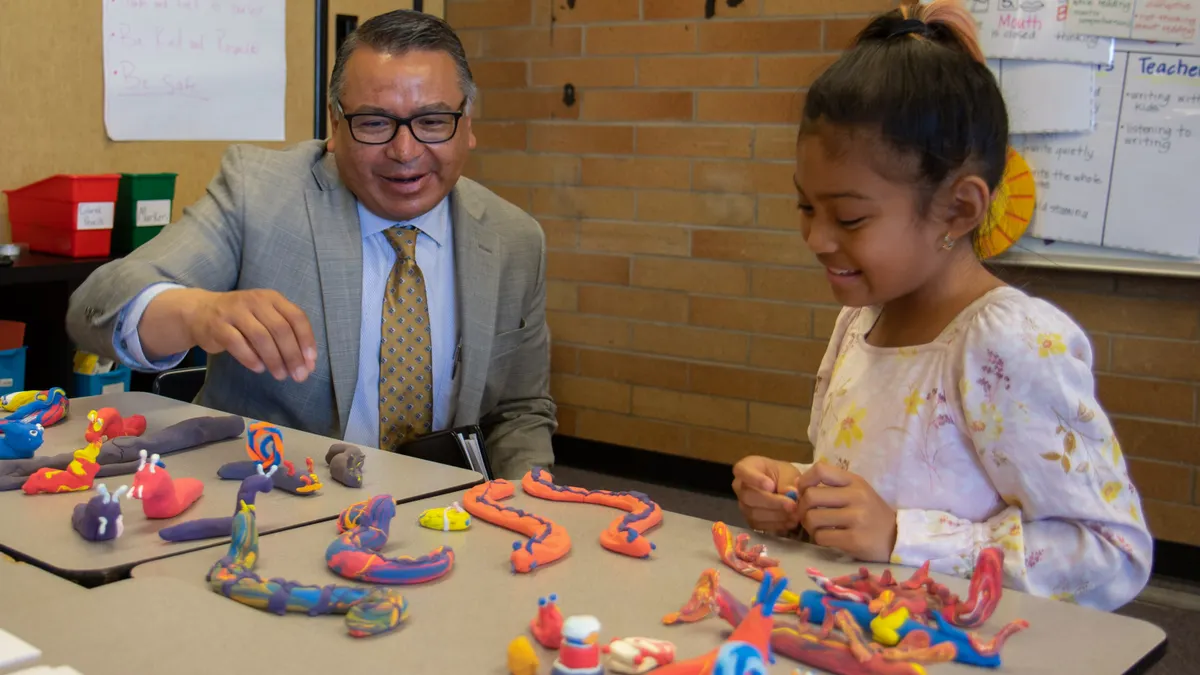Technology coaches shared strategies for helping educators take charge of their technology professional development (PD), balancing teacher capacity, measuring success and more during a Tuesday afternoon session, led by Jeremy Shorr of the Teaching Institute for Excellence at ISTE 2018.
How do you help educators take charge of their tech learning?
Katie Siemer of Forward Edge told attendees that she’s big on building relationships with teachers as a starting point, because they’ll be more likely to be interested in what coaches are talking about if they get to know them on a personal level. Understanding their pain points and interests can help coaches target strategies effectively.
David Hayward of Pickerington Local School District (Ohio) echoed that sentiment, saying that he also likes to give teachers the opportunity to share and communicate with other people. Classrooms can often end up siloed, he said, so building relationships among teachers is also key — helping them not only own their material, but also share it with their peers.
Gregory Gilmore of Osage Trail Middle School (Mo.) noted that what they were talking about is building culture and creating an environment where teachers feel safe and can trust each other. “That takes a lot of time and effort and patience to build that kind of trust between faculty,” he said. But once that is mastered, technology leaders can move on to building communication between school buildings.
Having a principal who’s geared toward doing that can serve as a catalyst to the process. Find out what the teachers and students are doing and saying and slowly bring the whole staff into the communication process. Encouraging them to visit each others’ classrooms so they can talk on the same plane is also key.
Mia Leonard of the National Teachers Academy in Chicago added that it’s also important to show teachers that it’s OK if they’re not familiar with a new tool.
How do you balance teacher capacity with the need for progress on new tech initiatives?
Allison Thompson of Lansing School District (Mich.) talked about how her district implemented a new math curriculum teachers didn’t really like. She related to them her own issues with math during school, but echoed Leonard in saying that it’s important to let them know mistakes are OK and that you likely Google how to do things, too. She also added that she often just sits and listens to teachers as they vent, asking later how she can make their job easier.
Leonard noted that it’s not always about reinventing the wheel, but adding a new tool to how teachers already do things, while Hayward reiterated that the most important skill to have is listening.
“We come at a teacher who doesn’t feel comfortable ... and if we try to tell them how it’s done, that’s not going to be an effective method going forward,” she said.
The speakers said that it's sometimes important to approach a reluctant teacher one-on-one rather than in groups to lessen that discomfort. Developing and implementing a solution together is also critical to keeping people on board, they said.
What are some easy ways to get people on your side in the first place?
While Gilmore described listening as "the first most important skill," he said asking questions is the second. This shows that the coach is working alongside the person instead of trying to work ahead of them. Ask things like, "What would you like to do to make this better?" or "What’s one thing you think could improve?"
Walking teachers through that and listening can often help them find the answers on their own.
Hayward then said that the greatest compliment he ever received is that he knows when to stop. He’s taken that further by only giving teachers a little bit of an idea at a time if he feels they’re not ready yet, based on where he can infer they’re at while listening. They’ll then come to him and ask for more when they’re ready.
What is the No. 1 piece of advice for a new tech integrationist?
Thompson said that because there was no job description or predecessor in the role in her district, she leaned on Twitter and similar resources. But her biggest piece of advice is for coaches to get to know their district: Walk around to classrooms, get to know educators, and come up with a plan that fits where everyone is at the time.
The conversation also focused on how to transition from teaching to being a technology coach. Gilmore said that some people don’t even know they’re technology coaches yet, but if they tend to be the one people come to when something isn’t working or they need help, they are probably already be doing the job without knowing it.
Hayward said he got into technology by getting in trouble with his district after creating a web page for his classroom to document and share what he was doing. His actions raised union issues, but he saw value in it. He was hired again by the same administrator to become an instructional coach because he had the confidence to back up what he was doing, even though the district wanted him to shut the site down. He also advised joining a professional learning network to learn more about what’s going on elsewhere and how to do that job.
How do you measure an initiative’s success?
Leonard said that in her school, they implemented the SAMR model to evaluate the use of technology in the classroom. Their goal is to integrate technology in ways that redefine teaching and learning. Developing rubrics and having "learning walks" to visit other classrooms are starting points for discussions on where teachers are, where they want to go, and how they can get there.
Hayward added that his district is the largest 1:1 implementation in central Ohio. It didn’t start with the device, though. It started with the director of technology planning in-depth how the devices would be rolled out and used. Having alignment from top-to-bottom, where educators can reflect on their progression and how new components fit into the plan is key.
“Am I spinning my wheels doing something that doesn’t need to be done? Is this really important for student learning?” he said.
Siemer added that technology integration specialists typically come from teaching, and that teachers on the whole are very humble people who might not think what they’re doing is really that great. Technology leaders must also wear a public relations hat, and share with administrators what teachers are doing while giving them credit for it rather than stealing teachers’ spotlights.
How do you avoid coach burnout and manage your workload?
When there is one technology coach and multitudes of teachers, this can be a challenge. Leonard also teaches kindergarten and said that looking at the individual needs of the teachers is critical. Just as teachers personalize learning for students, coaches must do so for teachers.
Siemer expanded by pointing out that people often have similar needs, so organizing group meetings around those can be key — whether in person or, as Gilmore chimed in, via a screencast.
And don’t just pick the techie teachers. Go to the well-respected teachers and get them on board, even if they’re not good with technology, the speakers recommended. Their clout will bring others along.


















